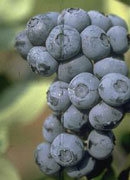


Home
Flowers &
Indoor Plants
Fruits & Nuts
Ornamentals
Vegetables
Special Topics
Resources
Glossary

|
Blueberry Vaccinium corymbosum (vax-in-ee-um core-um-bo-sum)      Click on thumbnails for larger image. |
 |
What about it? Blueberries, and their cousin the cranberry, are the only commercial fruit crops native to North America. Wild blueberries occur everywhere in North America except in the High Plains and the desert Southwest. The first hybrid blueberries were developed in the United States in the early 1900's. This truly "American" fruit has developed a world market, and programs for its improvement have begun throughout the world. What is it used for? Blueberries are used in baking, are made into jellies and jams, and are often eaten raw. Blueberries are also tasty in yogurt. Where does it grow? How do we grow it? Blueberries grow best on a sunny site in sandy peat soil, but they also do well in heavy soil with good aeration and drainage, high organic matter content, and adequate moisture. The most important requirement for growing blueberries is an acid soil. Spring planting of blueberries is recommended. Space rows 10 feet apart with 4 feet between each plant. Mulching is essential, since weeds compete with the blueberry for the limited available moisture and nutrients in the soil. Sawdust that has composted for a year or more is an ideal muclh for blueberries, but resourceful gardeners have been known to use many other materials. What are its primary problems? Blueberries are very susceptible to the cold injury. Plant in a protected location, and choose appropriate cultivars for New York, such as 'Patriot' and 'Bluecrop'. Half-high hybrids can be planted in the colder regions of the state. Some of the diseases that commonly infect the blueberries include powdery mildew, Fusicoccum canker, Phomopsis canker, and mummy berry. The most common and destructive insect is the blueberry maggot. The losses from bird damage can also be substantial. How do we harvest and store it? If left on the bush after ripening, blueberries do not spoil for at least one week. Flavor and sweetness increase, but unfortunately this makes the berries very attractive to birds. It is best to pick fruit while still slightly tart to avoid bird injury. Keeping fruit at a cool temperature after picking will increase their storage life.
© Copyright, Department of Horticulture, Cornell University. |